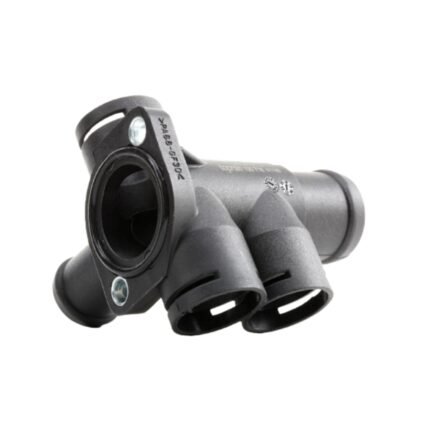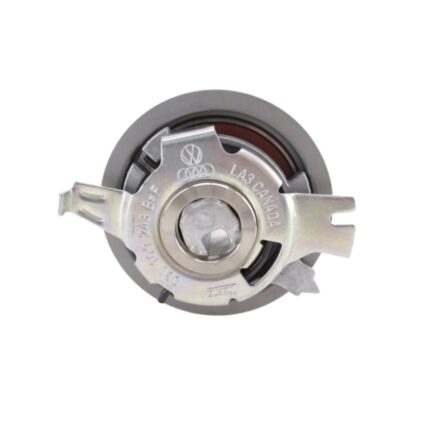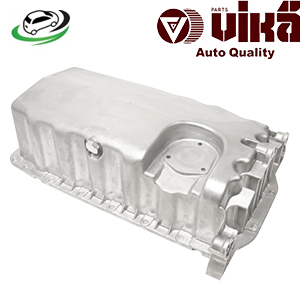Get VW Beetle 1.9L/ Beetle 2.0L A/T/ Beetle Convertible 1.9L/ Golf 1.9L/ Golf 2.0L/ Jetta 1.9L Engine Oil Pan 038103601NA
The engine oil pan is a reservoir located at the bottom of the engine. Its main role is to hold the engine oil when it is not circulating through the engine. It also serves as a housing for the oil pump, the drain plug, and sometimes the oil filter.
The pan is typically made of steel or aluminum and is bolted to the bottom of the engine block. Its shape is designed to hold a specific amount of oil (as recommended by the manufacturer), and it has channels and baffles to prevent the oil from sloshing around too much, which could cause engine performance issues.
2. How Does an Engine Oil Pan Work?
The oil pan is at the lowest point of the engine’s lubrication system, where oil collects after circulating through the engine. Here’s how it functions within the broader oiling system:
- Oil Storage: When the engine is off or idling, the engine oil pan holds the oil. This stored oil is essential for engine lubrication and cooling once the engine starts running.
- Oil Pickup: The oil pan is also the place where the oil pump picks up oil for circulation. The oil pump draws oil through a strainer located near the bottom of the oil pan. This strainer helps filter out any large debris that might damage the engine.
- Oil Circulation: As the engine runs, oil is pumped from the oil pan into the engine block, where it circulates to critical components such as the crankshaft, camshaft, pistons, and other moving parts. After lubricating and cooling these components, the oil drains back into the pan for recirculation.
- Oil Cooling: In addition to storage, the oil pan acts as a cooling surface for the engine oil. The oil cools as it comes into contact with the air passing around the pan. Some oil pans even feature fins or larger surface areas to increase their cooling efficiency.
- Drainage Point: The engine oil pan also has a drain plug that allows for easy oil changes. This drain plug is crucial for maintenance and should be sealed tightly to prevent leaks.
3. Functions of an Engine Oil Pan
The engine oil pan serves several essential functions, making it a critical component in maintaining engine health:
- Oil Storage: The oil pan stores the engine oil needed for lubrication and cooling while the engine is not running or when the oil is not being circulated by the pump.
- Heat Dissipation: As the oil collects in the oil pan, it cools down, dissipating the heat it accumulated during circulation. The larger the oil pan or its surface area, the more efficient this cooling process becomes.
- Debris Collection: The oil pan also serves as a collection point for debris and sludge that may accumulate in the oil. While filters catch the majority of contaminants, small particles can settle at the bottom of the oil pan over time.
- Oil Management: The oil pan helps manage the oil’s flow within the engine. Baffles within the pan prevent the oil from sloshing excessively, especially during sharp turns or sudden movements. This helps ensure a steady supply of oil to the pickup tube and oil pump.
4. Types of Engine Oil Pans
Engine oil pans can vary based on material, design, and specific use cases. Below are the common types:
1. Steel Oil Pans
- Material: Steel is commonly used in oil pans due to its durability and cost-effectiveness.
- Advantages: Steel oil pans are sturdy, resistant to impacts, and are generally less expensive than aluminum pans.
- Disadvantages: Steel can rust over time, especially if exposed to moisture or road salt, leading to potential leaks.
2. Aluminum Oil Pans
- Material: Aluminum oil pans are lighter than steel pans and are often found in performance vehicles.
- Advantages: Aluminum is lightweight, resists corrosion better than steel, and provides better heat dissipation due to its superior thermal conductivity.
- Disadvantages: Aluminum is more prone to cracking if hit by road debris or during off-road driving.
3. Dry Sump Oil Pans
- Design: Dry sump systems use a different type of oil pan, typically much shallower than wet sump systems, because they store oil in an external tank rather than in the pan itself.
- Advantages: Ideal for high-performance vehicles, dry sump systems prevent oil starvation during high-speed cornering and other extreme driving conditions.
- Disadvantages: They are more expensive and complex, making them less common in everyday vehicles.
5. Benefits of a Properly Functioning Engine Oil Pan
A properly functioning oil pan is critical for overall engine health. Here are some of the benefits:
- Prevents Engine Overheating: The oil pan stores and cools the oil that circulates through the engine, reducing friction and preventing the engine from overheating.
- Ensures Consistent Lubrication: A properly designed oil pan ensures that oil is available for circulation, especially during maneuvers that might shift the oil in the pan, such as hard braking or fast turns.
- Reduces Contamination: The oil pan collects debris and metal shavings that might circulate through the engine, allowing them to settle at the bottom, minimizing the risk of them entering the lubrication system.
- Facilitates Easy Maintenance: The oil drain plug in the oil pan makes oil changes straightforward, ensuring proper engine care and longevity.
6. Common Problems with Engine Oil Pans
Engine oil pans are sturdy, but they are not immune to problems. Some of the common issues include:
- Oil Leaks: One of the most frequent problems with oil pans is leaking oil. Leaks can occur due to a damaged oil pan gasket, a loose or stripped drain plug, or cracks in the oil pan itself.
- Rust and Corrosion: Steel oil pans are particularly susceptible to rust and corrosion. Over time, moisture and road salt can cause the metal to degrade, leading to leaks.
- Physical Damage: Potholes, road debris, or off-road driving can dent or crack the oil pan, especially if it’s made from aluminum. A damaged oil pan can cause oil to leak or even result in oil starvation if the damage blocks the oil pickup.
- Worn-Out Drain Plug: The oil drain plug is removed and re-installed during every oil change. Over time, this can cause the threads to wear out or strip, leading to leaks. In some cases, overtightening the plug can also crack the oil pan.
- Improper Installation: Incorrect installation of the oil pan, particularly the oil pan gasket, can lead to leaks. If the gasket is pinched or not aligned properly during installation, oil will escape from the gaps.
7. Maintenance and Replacement of Engine Oil Pan
Proper maintenance of the oil pan is crucial for extending the life of your engine. Here are some maintenance tips and guidelines for replacement:
Regular Inspections
- Inspect the oil pan periodically for signs of damage, such as dents, cracks, or rust. Pay attention to the area around the drain plug and the oil pan gasket.
Check for Leaks
- Keep an eye out for oil leaks under the vehicle, especially around the oil pan gasket and drain plug area. If you notice oil puddles or drips, it could be a sign of a damaged gasket or loose drain plug.
Oil Changes
- When performing oil changes, ensure that the drain plug is properly tightened and not over-tightened. Always replace a damaged or stripped drain plug to prevent leaks.
Gasket Replacement
- The oil pan gasket should be replaced during oil pan installation or when there is evidence of a leak. A damaged gasket is one of the most common causes of oil leaks.
Use of Skid Plates
- If you frequently drive on rough roads or off-road, consider installing a skid plate to protect the oil pan from debris or impact damage.
Replace a Damaged Pan
- If the oil pan is cracked or heavily corroded, it should be replaced. Ignoring a damaged oil pan can lead to serious engine issues, including oil starvation and engine seizure.
Conclusion
The engine oil pan plays a critical role in the lubrication and cooling of your vehicle’s engine. It serves as the oil reservoir, facilitates easy maintenance through the drain plug, and helps cool the oil while preventing contamination. Proper maintenance of the oil pan, including regular inspections and timely replacements of the gasket and drain plug, is essential for long-term engine health. Whether made of steel or aluminum, the oil pan’s functionality is key to keeping your engine running smoothly and efficiently.
Follow us on Facebook for more parts.




Reviews
Clear filtersThere are no reviews yet.